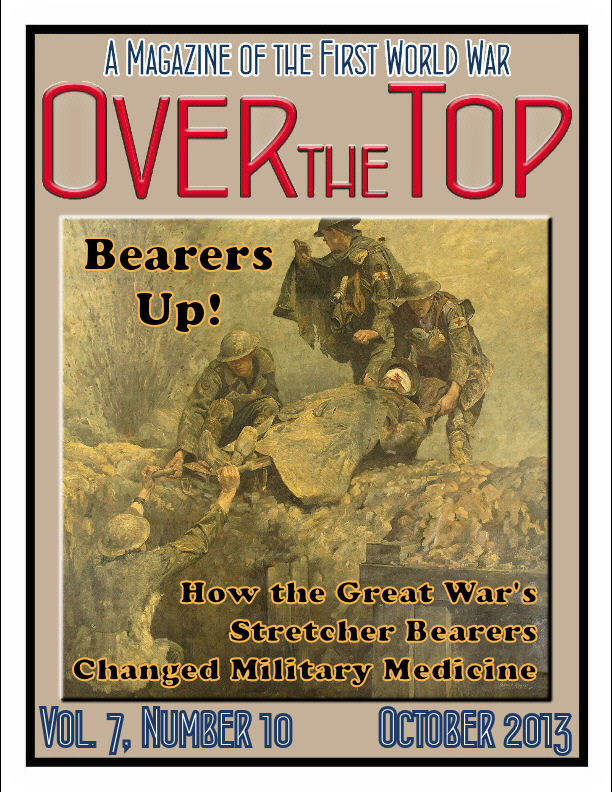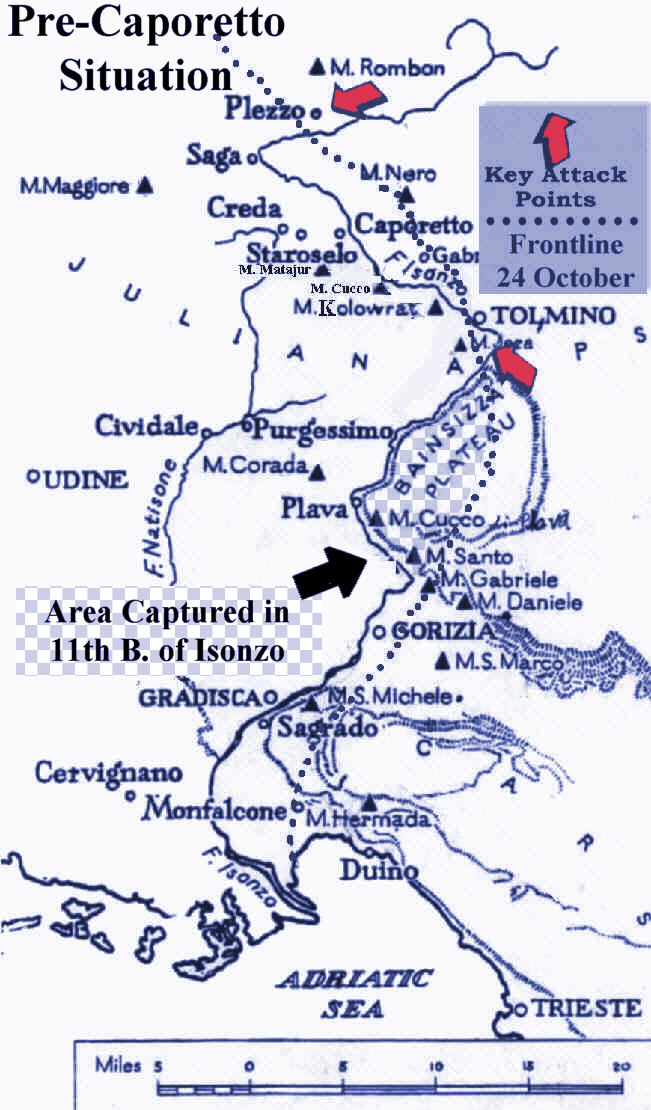
October 2013 |
 |
|


Help Us Reach Out
Welcome to our latest issue. I hope you enjoy our latest monthly compilation of World War I news, history, and centennial activites. As you know, we have started a daily blog, Roads to the Great War, as an additional outlet for all the material on the events of 1914-1918 that keeps flooding into us. While readership for the Trip-Wire has reached all-time highs (thank you very much), traffic at the blog has flattened out at a much lower level.
We think this may be because a lot of you just don't like to subscribe to sites that send you a daily email announcement you see in your inbox. What we suggest, in this case, is that you visit the site once (just click on the banner below) and set it as a favorite or bookmark. That way you can access it quickly at your leisure, when you are interested in revisiting those important events of the First World War. Also, we think some of you might not be aware of the quality of the contributions we are receiving for Roads. Below is a list of representative articles from each of our month's daily production. Please try them out. If you like what you see, become a subscriber or a regular visitor, and check the archives of our nearly 150 articles to date. MH
 Brilliant Wartime Illustrator Fortunio Matania
Brilliant Wartime Illustrator Fortunio Matania
 David Beer on the War's Literature
David Beer on the War's Literature
 The German Experience at the Somme
The German Experience at the Somme
 Japan Enters the War
Japan Enters the War
 The St. Mihiel Offense: 12-16 September 1918
The St. Mihiel Offense: 12-16 September 1918

|
2013
 League of WWI Aviation Historians, Atlantic Chapter, 12th Meeting, Steven F. Udvar Hazy Center, National Air & Space Museum, Dulles Airport, All-Day. League of WWI Aviation Historians, Atlantic Chapter, 12th Meeting, Steven F. Udvar Hazy Center, National Air & Space Museum, Dulles Airport, All-Day. Rescheduled for
Saturday, 16 November 2013
Downloadable Program and Details
 New York State Military Museum, "Fiery Trial and Sacrifice - New York and the First World War," ongoing exhibit, Saratoga Springs, NY. Virtual Tour. New York State Military Museum, "Fiery Trial and Sacrifice - New York and the First World War," ongoing exhibit, Saratoga Springs, NY. Virtual Tour.
 The National World War I Museum in Kansas City, MO, has a current exhibit running on "The Road to War," running through April 2014. Website. The National World War I Museum in Kansas City, MO, has a current exhibit running on "The Road to War," running through April 2014. Website.
 WW1HA Bay Area Chapter Meeting: Catherine Miskow on "The Lafayette Escadrille," 12 October, Albany, CA Veterans Hall, 10:30 A.M., 1325 Portland Ave. Email Sal Compagno for details. WW1HA Bay Area Chapter Meeting: Catherine Miskow on "The Lafayette Escadrille," 12 October, Albany, CA Veterans Hall, 10:30 A.M., 1325 Portland Ave. Email Sal Compagno for details.
 The MacArthur Memorial and Museum in Norfolk, VA, has a current exhibit running on "The 42nd 'Rainbow' Division in World War One," running through September 2014. Website. The MacArthur Memorial and Museum in Norfolk, VA, has a current exhibit running on "The 42nd 'Rainbow' Division in World War One," running through September 2014. Website.
 Western Front Association — East Coast Symposium, Authors Richard Rubin & Robert Dalessandro and much more; Saturday 12 October 2013 at the York County Heritage Trust, York, PA. Download Flyer. Western Front Association — East Coast Symposium, Authors Richard Rubin & Robert Dalessandro and much more; Saturday 12 October 2013 at the York County Heritage Trust, York, PA. Download Flyer.
2014
 The U.S. Air Force National Museum at Wright-Patterson AFB, OH, and the League of WWI Aviation Historians (OvertheFront.com), are collaborating on what will be the first U.S.-based mega-event for the WWI centennial. The League is scheduling its 2014 Seminar to correspond with the WWI Dawn Patrol Fly-In at the Museum in Dayton, OH, 24-28 September 2014. Mark it down on your calendar. The U.S. Air Force National Museum at Wright-Patterson AFB, OH, and the League of WWI Aviation Historians (OvertheFront.com), are collaborating on what will be the first U.S.-based mega-event for the WWI centennial. The League is scheduling its 2014 Seminar to correspond with the WWI Dawn Patrol Fly-In at the Museum in Dayton, OH, 24-28 September 2014. Mark it down on your calendar.
|
|
The "Fateful" Franco-Russian Alliance Honored by a Poilu
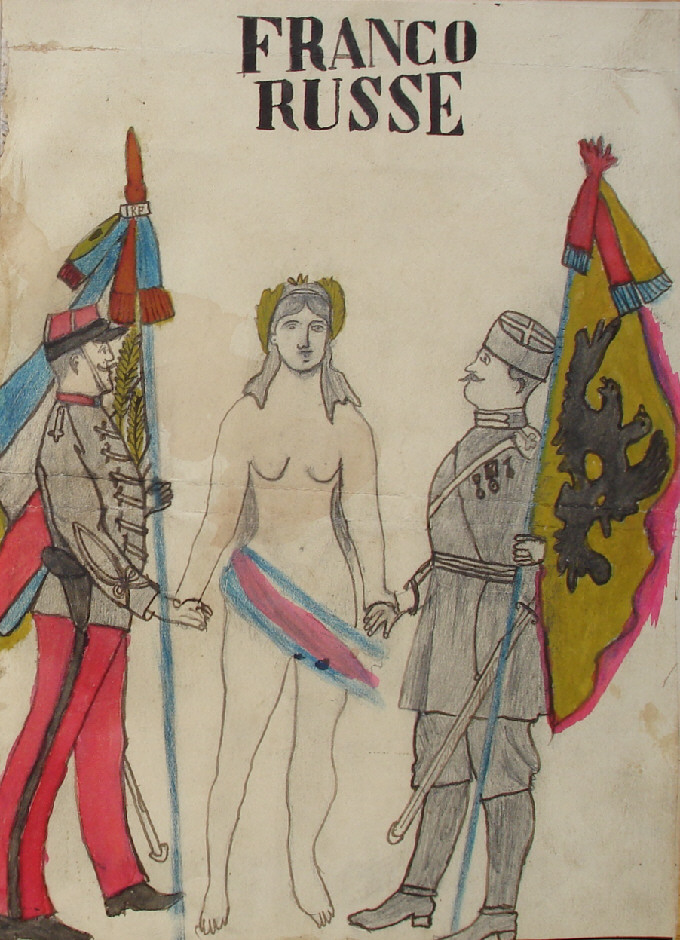
From the Notebooks of Soldat Jules Chamberet, 138th Regiment
Contributed by
His Grandson Olivier Pierrard

Last of the Central Powers
In October of 1915 Bulgaria, the last of the four Central Powers, joined the war. They thought they were joining the winning side and would correct the national indignities they suffered while losing the Second Balkan War.
 11 October 1915: Bulgaria Enters the War
11 October 1915: Bulgaria Enters the War
 Bulgaria in the First World War by Richard C. Hall (Overview)
Bulgaria in the First World War by Richard C. Hall (Overview)
 The Lion's tale - Bulgaria in World War I (Excellent maps and illustrations)
The Lion's tale - Bulgaria in World War I (Excellent maps and illustrations)
 Bulgarian History: Photo Album of WWI
Bulgarian History: Photo Album of WWI
 Bulgarian Aviation in the Great War
Bulgarian Aviation in the Great War
 Tsar Ferdinand
Tsar Ferdinand
 Battle of Dobro Pole
Battle of Dobro Pole
 The End of Bulgaria as Told by Pvt. N.C. Powell 3/5th East Lancs.
The End of Bulgaria as Told by Pvt. N.C. Powell 3/5th East Lancs.

First and Last Ships Sunk?
Old Fritz had to do a little research "out of his depths" on this one. He originally joined the infantry because he knew that—if he joined the Kriegsmarine—he would just be seasick all the time. Anyway, Fritzie says that the first ship to be sunk in the Great War was the German auxiliary minelayer SS Königin Luise, which was scuttled after damage by Royal Navy fire on 5 August 1914. It had been attempting to lay mines off of the Thames Estuary.
The last ship sunk was the pre-dreadnought British battleship HMS Britannia. It was enroute to Gibraltar when she was torpedoed off Cape Trafalgar on 9 November 1918 by U-50.
Rededication at the Verdun Battlefield
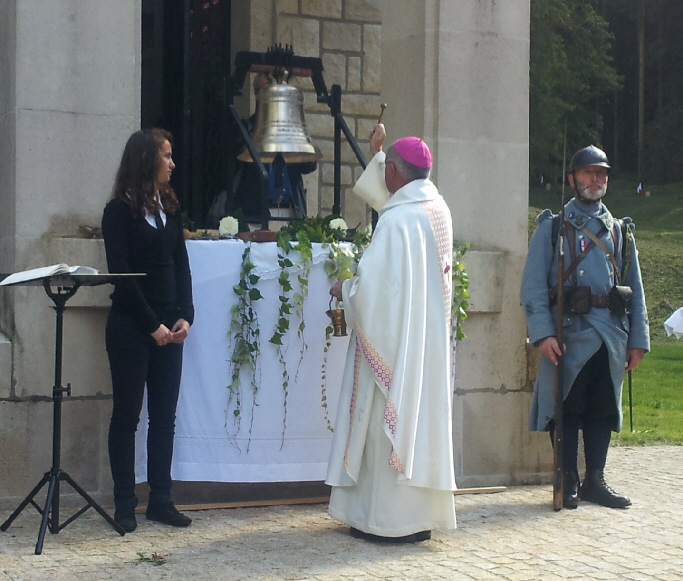
On 22 September 2013, 97 years after the bell in the church at Beaumont village was destroyed during the Battle of Verdun, a new bell was baptised by the Bishop of Verdun. It is named Marie Apolline and will be hung in the chapel. Beaumont is one of the destroyed villages on the Verdun battlefield.
(By Correspondent Christina Holstein)

You can be a virgin in horror the same as in sex. How, when I left the Place Clichy, could I have imagined such horror? Who could have suspected, before getting really into the war, all the ingredients that go to make up the rotten, heroic, good-for-nothing soul of man? And there I was, caught up in a mass flight into collective murder, into the fiery furnace. . . Something had come up from the depths. . . Men are the thing to be afraid of, always, men and nothing else.
French Veteran and Author Louis-Ferdinand Céline
Novel, Journey to the End of Night
|

|

U.S. Centennial Organizations & Resources
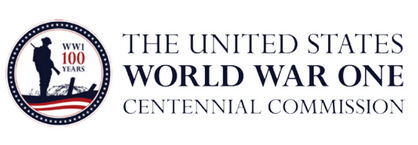
worldwar-1centennial.org/
|
September was a period of real progress regarding the preparations for America's commemoration of the Great War. The new national commission held their first meeting in Kansas City, elected a chairman, The Honorable Isaac Newton "Ike" Skelton IV, former U.S. Representative for Missouri's 4th Congressional district, and, as vice-chairman, Colonel Robert Dalessandro, Executive Director and Chief of Military History, U.S. Army Center of Military History. Congratulations and best wishes to both of them. As you will see below, the commissioners swung into action immediately, with the coordination of America's centennial effort with the other participating nations an early priority. MH
News About the WW1 Centennial Commemoration Commission
WASHINGTON, DC (9/19/2013) — The initial meeting of the World War One Centennial Commission took place on Friday, 13 September 2013, at the National World War I Museum at the Liberty Memorial in Kansas City, MO. The eleven commissioners present were sworn in, and the commission officially commenced operation.
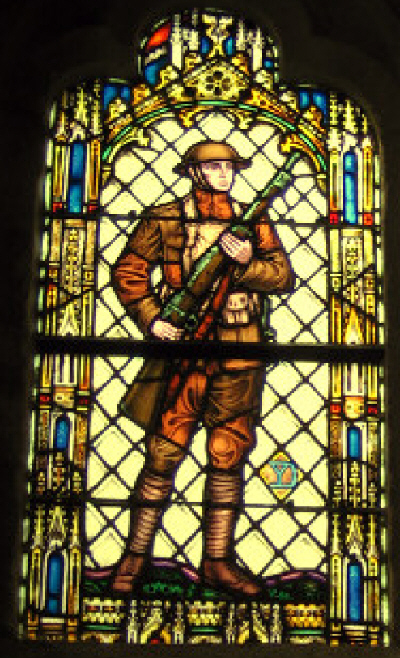
Doughboy Stained Glass
26th Division Church
Belleau Village |
The Commission was established by the World War I Centennial Commission Act, part of Public Law 112-272 passed by the 112th Congress and signed by thePresident on 16 January 2013. The Act mandated that the Commission's first meeting take place at the museum after all commissioners were appointed.
As its first order of business, the commission elected Commissioner Ike Skelton as Chairman, and Commissioner Rob Dalessandro as Vice Chairman. Chairman Skelton appointed the Designated Federal Official (DFO). Under the Federal Advisory Commitee Act, the DFO performs a variety of functions for the commission. Three members of the public addressed the commission. The initial meeting ended with a general discussion of the commemoration of the Great War.
Subsequent to the meeting several commissioners met in Washington, DC, at the Navy Memorial with the attachés of other nations organizing centennial commemorations, including those of the UK, France, Germany, Austria, and Belgium. In October, Vice-Chairman Robert Dalessandro will fly to Paris to represent the U.S. at a meeting of the centennial commissions of all the participants.
The commission's website is still in start-up mode, but already has some excellent features. Highly recommended is their article on The Star Spangled Banner and World War I.
The MacArthur Memorial Promotes the Centennial of the First World War
By Archivist James Zobel
The centennial commemoration of the First World War has already begun at the MacArthur Memorial. Located in Norfolk, VA, the memorial is the final resting place of General of the Army Douglas MacArthur and his wife Jean. It is also a historical center with a nine-gallery museum, an HD theater, and a vast archives housing the papers of General MacArthur, his subordinate commanders, and thousands of veterans who served with both him and his father from the American Civil War through the Korean War. It was in the First World War that Douglas MacArthur was made one of the youngest brigadier generals of the AEF and commanded a brigade of the famous 42nd Infantry or "Rainbow" Division. The MacArthur Memorial, therefore, is playing a key role in promoting the upcoming centennial.

The Memorial Flanked by Items from the Rainbow Division Exhibit
In October 2012 the special exhibit Under the Rainbow: The 42nd "Rainbow" Division in the Great War was opened in the brand-new MacArthur Memorial Visitor Center to kick off the Memorial's centennial activities. This exhibit tells the story of the officers and men of the Rainbow Division from its inception at Camp Mills, NY, in the summer of 1917, across the battlefields of France, and into occupation service in Germany until the dissolution of the division in the spring of 1919. Many of the items exhibited have never before been on display at the MacArthur Memorial, and includes uniforms, equipment and personal items of the men of the Rainbow as well as other Allied countries and Central Powers. Among the highlights are uniform and equipment of Lt. Col. Cooper Winn, commander of the 151st Machine Gun Battalion; dog tag of the poet Joyce Kilmer, killed at the Second Battle of the Marne in July 1918; set of German trench armor; and an extensive collection of Rainbow Division Veterans Association memorabilia. The exhibit runs from October 2012 to September 2014.
The MacArthur Memorial has also begun a World War I podcast series produced by the memorial's education department to commemorate the centennial. The series explores the history of the war from a variety of perspectives. From the assassination of Archduke Franz Ferdinand to the major battles, policies, and key players of the war, over the next several years these podcasts will seek to answer some of the major questions of the war. What were the causes? How did this war redraw the political and social map of the world? And most important, why does this war still matter? Current episodes feature lectures from distinguished historians as well as presentations by the MacArthur Memorial staff. Each episode is available for free download from the MacArthur Memorial website or from iTunes.

Click on Image for List and Access to Podcasts
|
Editor's Commentary
These podcasts are absolutely terrific. The presenters include top-notch WWI authors and the memorial's education director, Amanda Williams, who seems to have comprehensive knowledge of the major issues of the war and the AEF. Highly recommended for schools, too. MH
|
Over the next four years, 2014-2018, the MacArthur Memorial will commemorate the centennial through special exhibits, online presentations, and historical symposia. We invite everyone to join us and also help out. We are always looking for new materials and areas of exploration. Please contact the MacArthur Memorial at:
MacArthur Memorial
MacArthur Square
198 Bank St.
Norfolk, VA 23510
Tel: 757 441-2965
Email: james.zobel@norfolk.gov
|

theworldwar.org/
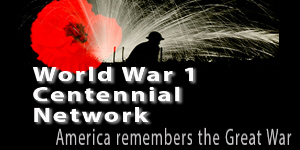
www.ww1-centennial.org/

history.army.mil/

www.firstdivisionmuseum.org/

www.abmc.gov/
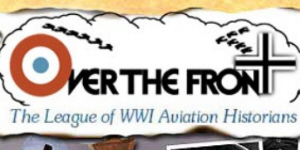
www.overthefront.com/

www.nationalmuseum.af.mil/
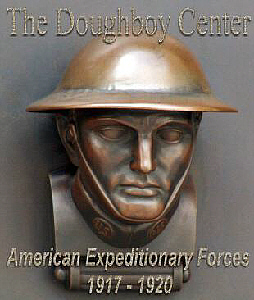
www.worldwar1.com/dbc/

wwi-inventory.org/

wisconsinhistory.org/

www.uswarmemorials.org/

www.macarthurmemorial.org/
|
|

October 1913
Albania Becomes a Testing Ground for National Wills
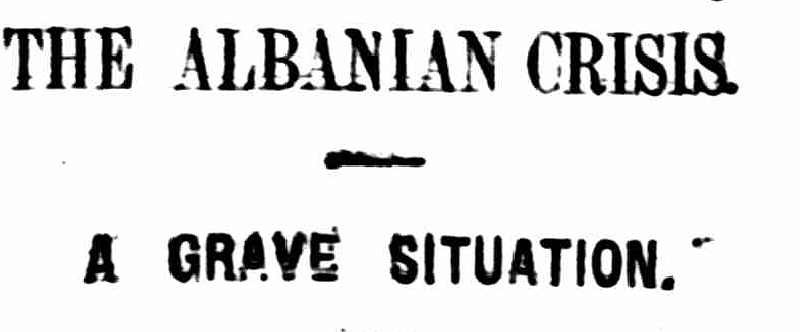
Australian Newspaper Headline, 26 September 1913
Out of the settlement of the Balkan Wars of 1912 & 1913 evolved a decision by the Great Powers that a buffer state—Albania—would be created along the Adriatic Sea. Albanian had proclaimed its independence in November 1912, and the new nation was recognized by the Conference of London on 29 July 1913. Albania's political function was to allow Serbia—–the big winner of the recent wars—–to have some commercial access to the ocean, while preventing it from developing naval facilities in the Adriatic that would threaten the sole Austro-Hungarian water access.
Serbia, however, was never happy with the arrangement and kept troops and guerillas active in Albania, while negotiating with friendly Balkan neighbors to divide Albania among themselves. The Albanians, who were not happy about the settlement imposed on them either, were determined to reseist the Serbian incursions. Matters came to a head in October 1913 after the hawks in Vienna, led by Chief of Staff Franz Conrad von Hötzendorf, convinced Foreign Minister Count Leopold Berchtold that a firm stand against Serbia over Albania was needed.
In September Berchtold's representative in Belgrade confronted the Serbians, who simply lied and said they were totally withdrawing their troops from Albania. They only shifted them around a bit. Soon, the deception was discovered and the Austrians decided to up the ante. Chronologically, this is what ensued in October 1913:
Ethnic Nationalism in
the Balkans & Europe
|
|
3 October: The government of Austria-Hungary passed a bill increasing the size of its army to 600,000 men, and authorizing an army of 2,000,000 men in the event of war. This followed the army expansions of the other powers discussed in the August issue of the Trip Wire.
The timing of the expansion, however, also served the purpose of sending a clear military signal to the Serbians.
16 October: The Albanians stirred the diplomatic pot themselves, when one faction decided to declare its own "Republic of Central Albania." This, of course, alarmed the Austrians further. (This new state was disbanded three months later after pressure from the big powers determined to calm down the Balkans.)
18 October: Acting solely on its own, Austria-Hungary issued an ultimatum to Serbia demanding that Serbian troops be withdrawn within eight days from the territory set aside for Albania by the Great Powers. Not even Germany was consulted before the ultimatum. Arthur Zimmerman, then deputy foreign minister of Germany told the British smbassador to Berlin that the Germans had been surprised by Austria's ultimatum as a policy that "might lead to serious consequences," but added that "restraining advice to Vienna on the part of Germany was out of the question."
25 October: One day before the expiration of the eight-day ultimatum given by Austria-Hungary on 18 October, Serbian troops withdrew from Albania. The crisis seems to have passed, but—as we know—not really.
In hindsight, what are the lessons here? First, by October 1913 the Great Powers were not unified. Not even Germany and Austria-Hungary were being candid with one another. Second, Russia was once again embarrassed by a Slavic client (as the Russians perceived things), while appearing to be ineffectual in dealing with a crisis in its sphere of influence. Lastly, Serbia and Austria-Hungary, indeed, had irreconcilable differences and were willing to fight over them regardless of the consequences.
Sources: Mtholyoke.edu; Mentalfloss.com; Wikipedia
|
|

Flyers and application form for 2014 "Opening Moves" and
"Miracle of the Marne" Trips Now Available
(download pdf file here)

Click on Image to Send Email
|
|
|

|

Marcel Duchamp
(1887-1968)
French Avant-Garde Artist
|
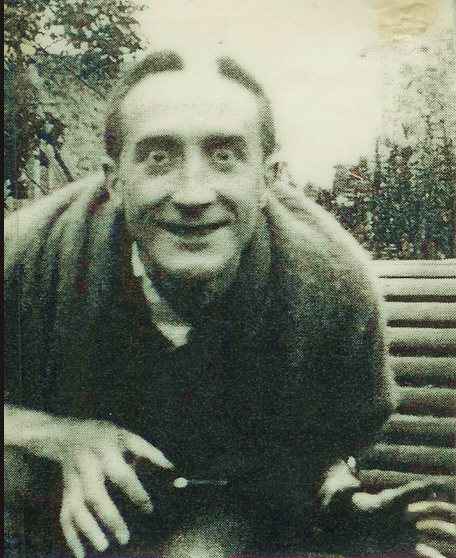
Seriously Unconventional
| |
In 1913 French artist Marcel Duchamp had made waves at the New York City "Armory Show," which introduced America to modern art. His synthesis of cubism and futurism titled "Nude Descending a Staircase" (see below) left the patrons speechless. When war came the following year, he was exempt (temporarily) from the draft since he had already performed his one-year service. Things got worse for France on the battlefield, though, and deferrments were cancelled. As biographer Calvin Tomkins wrote:
Duchamp was summoned before a draft board in January 1915.
In the course of his physical exam however, it was discovered that he had a
slight rheumatic heart murmur — nothing serious, but enough to keep him out
of the army. "I have been condemned to remain a civilian for the entire duration of the war," he wrote to [his patron,Walter] Pach who was back in New York by this time. "They found me too sick to be a soldier. I am not too sad about this decision: you know it well."
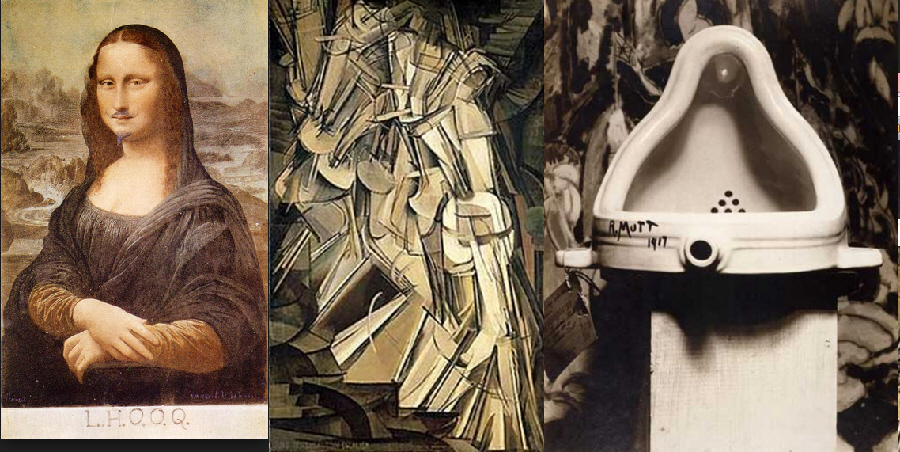
Signature Works: Mona Lisa with Mustache; Nude Descending a Staircase, #2; Fountain
His exemption made him quite unpopular, naturally. Duchamp escaped to New York and spent two productive years there. But then America entered the war, so he fled to Argentina for nearly a year in artistic exile, eventually returning to France in 1919. After exploring new artistic forms he became obsessed with chess, and the rest of his career was remarkably unproductive. Yet, he remains enormously influential and is considered one of the founders of both DADA and Surrealism.
George M. Cohan
(1878-1942)
Song Writer, Entertainer, Producer
George Michael Cohan began his career as a child, performing with his parents and sister in a vaudeville act known as "The Four Cohans." Beginning with Little Johnny Jones in 1904, he wrote, composed, produced, and appeared in more than three dozen Broadway musicals. Cohan published more than 300 songs during his lifetime, including American standards "Give My Regards to Broadway," "Yankee Doodle Dandy," and "You're a Grand Old Flag." He displayed remarkable theatrical longevity, appearing in films until the 1930s, and continuing to perform as a headline artist until 1940.
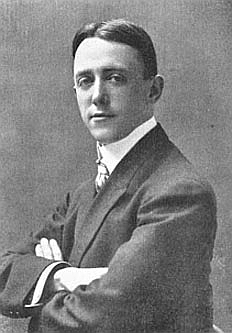
George M. Cohan |
Known in the decade before World War I as "the man who owned Broadway," Cohan is considered the father of American musical comedy. His life and music were depicted in the Academy Award-winning film Yankee Doodle Dandy (1942) and the 1968 musical George M! A statue of Cohan in Times Square in New York City commemorates his contributions to American musical theater.
Shortly after America entered the Great War, while riding on a train, Cohan was inspired to write a patriotic song. He modeled it on a bugle call, inspiring Americans to cross the seas for service in a foreign land. "Over There" was an instant success, selling over two million copies by the end of the war. Perhaps the most popular version of "Over There" was sung by Nora Bayes, but Enrico Caruso and Billy Murray also sang beautiful renditions. The dynamic Cohan and his partners presented over a dozen shows and plays on Broadway during 1917 and '18, without a heavy patriotic emphasis in most. At the time of the Armistice he produced a show with the troops from nearby Camp Merritt titled Good Luck, Sam! that ran for about a month. Nevertheless, he is forever connected to the American experience in the Great War. On 29 June 1936, President Franklin Roosevelt presented him the Congressional Gold Medal for the boost "Over There" and Cohan's other musical efforts gave to the nation's morale.
Sources: Wikipedia, Musical101
|
|

Support Roads to the Great War by shopping through us at Amazon.com. This is how we keep our free publications rolling along and you don't have to buy any WWI books to help us. Once you click on any of my favorite WWI titles below, we get credit for any type of sale.
The Editor's Favorite Great War Classics
|

Tank Cigarette Cards
From the Collection of Cyril Muzansky
|
Cigarette cards were a marketing device long before the Great War. During hostilities, tobacco companies— especially British— generated war-oriented series using weapons, ships, politicians, generals and Victoria Cross recipients, etc., as subjects. In the 1990s some companies returned to the war and issued updated cards. Wills (Castella), issued "The Story of the Tank." Shown below are the Mark IV (front and back) and the Whippet cards from the series. The models used for the photos seem fully accurate as do the details provided on the Mark IV. This is why these cards earned their place in the "Real Deal."

(Right Click "View Image" or "Open Image in New Tab" to View Full Size)
|
|
|

Precursor to Caporetto,
The Eleventh Battle of the Isonzo
Last Month, we presented an article on the war on the Italian Front post-Caporetto. This month, we are going back a few weeks in time and look at the operation that necessitated an offensive on the Italian Front by the Central Powers to salvage their declining situation there.
The Eleventh Battle of the Isonzo
August 19 - September 12, 1917

Depiction of Austrian Troops Defending Against an Italian Attack on 24 August 1917
Unable to clear the Austrian 5th Army off the dangerous Tolmino Bridgehead (see map below), where Austrian forces were dug in on both sides of the river, during the earlier 10th Battle of the Isonzo, the Commando Supremo of Chief of Staff Luigi Cadorna developed a plan for both flanking that position and threatening the enemy's rear marshalling areas, possibly even gaining another route to ever-elusive Trieste. The objective was to capture the Bainsizza Plateau southeast of Tolmino. Unfortunately the planners combined this somewhat creative solution with the old standby scheme for capturing Trieste (Isonzo Battles 1-10) by just pounding very, very hard through the Carso Plateu further south. Guided by this two-pronged strategy, Italy's Second and Third Armies began the largest of all the Isonzo Offensives on 19 August 1917. Fifty-two divisions were committed to the operation.
In both areas the attackers suffered from the same handicap. The Bainsizza and Carso have been described as "enormous natural fortresses." The new target for 1917, the Bainsizza, rises so rapidly and so high from the Isonzo that a frontal assault would be nearly suicidal. For once, however, tactics were adjusted to the situation. In another admirable bit of creativity it was decided that the plateau, with the help of fourteen bridges to be placed across the river by engineers, would be assaulted from the north at a section where the terrain was not nearly as challenging for assault troops. Despite heavy casualties the men of Italy's 24th Corps crossed the river, advanced behind an effective artillery barrage, forced their adversaries to withdraw and eventually occupied about half of the plateau.
On the south edge of the plateau a secondary attack was staged from Mte Cucco (Kuk) resulting in the capture of fortified Mte Santo which had resisted successfully in the 10th Battle. These advances over the plateau stopped when the artillery support was not able to follow further, and the Austro-Hungarian forces, always good on the defense, started taking advantage of the many caverns and hiding places provided by the Bainsizza's weird geology. Nevertheless, next to the success of the 6th Battle of the Isonzo when Gorizia was captured, this effort was the most impressive military achievement by the Italian Army on the Isonzo.
After a final, inadequate attempt to capture Mte Gabriele, which had been fortified with galleries and dugouts for years, the offensive ceased. General Luigi Capello’s 2nd Army capture of the Bainsizza Plateau, however, had strained Austrian resistance severely (although also exhausting the Italian forces). To avert an Austrian collapse, Erich Ludendorff decided that the Austrian Army must be provided German assistance to take the offensive along the Isonzo. This is the origin of the Battle of Caporetto. Cadorna sensed the Germans were about intervene and began concentrating on his defenses. Unfortunately for Italy, his deployments on the northern leg of the Isonzo would proved fatally flawed (see his weak points on the map, shown as the Key Attack points for Caporetto). That's a matter we will address in a future Trip-Wire.
|
|
|
Thanks to each and every one of you who has contributed material for this issue. Until November, your editor, Mike Hanlon. |
|
 (Or send it to a friend)
(Or send it to a friend)
|
Design by Shannon Niel
Content © Michael E. Hanlon
|
| |
|






